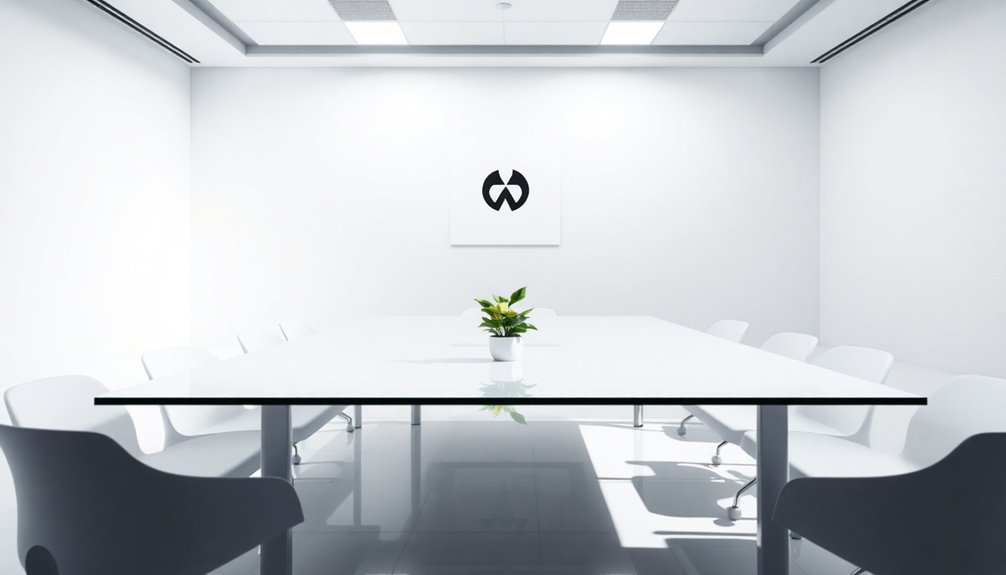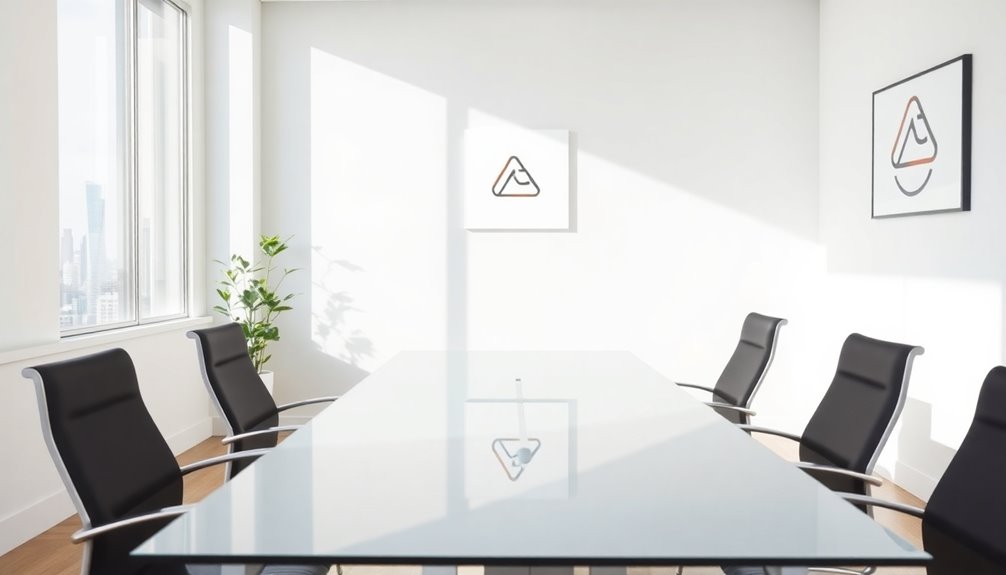Minimalism in corporate branding is all about cutting through the noise to convey your identity clearly and effectively. Brands like Apple and Tesla exemplify this trend, using clean designs, limited color palettes, and simplified typography to enhance recognition and trust. However, it's crucial to maintain distinctiveness to avoid oversimplification, which can dilute brand identity. You'll discover actionable strategies and insights that can help you embrace minimalism successfully and navigate its challenges.
Key Takeaways
- Minimalist branding innovations focus on clean designs that prioritize user experience, helping brands stand out in crowded markets.
- Companies leverage strategic color palettes and typography to evoke emotions and enhance brand recognition through simplicity.
- Iconic brands like Apple and Tesla exemplify the successful integration of minimalism, showcasing sleek designs that communicate innovation and sophistication.
- Future branding trends emphasize clarity and effective use of white space, capturing consumer attention in fast-paced digital environments.
- Balancing simplicity with distinctiveness is crucial to maintain brand identity and foster consumer loyalty amidst evolving design trends.
The Rise of Minimalism in Corporate Branding

As consumers are constantly bombarded with information, many brands have turned to minimalism in their corporate branding to cut through the noise. Inspired by Apple's clean design aesthetic, minimalist branding has become a popular design philosophy that emphasizes simplicity and sophistication.
By focusing on clean lines and stripped-down visuals, brands can effectively communicate their essence while standing out in cluttered environments. However, it's essential to strike a balance between simplicity and distinctiveness; over-simplification can dilute brand identity and make it hard for consumers to connect.
To succeed in minimalist branding, you must guarantee that your core message and values are clear and resonate with your audience, maintaining the personality that makes your brand memorable. Additionally, transparency in data handling builds trust with users, which is crucial in today's digital landscape.
Successful Examples of Minimalist Branding

When you think about minimalist branding, several iconic logos come to mind that perfectly illustrate its power.
Brands like Apple and Nike use effective color strategies and simple typography to create memorable identities.
Let's explore how these elements come together in successful minimalist branding examples. Additionally, the principles of color strategies can significantly influence brand recognition and consumer perception.
Iconic Minimalist Logos
Minimalist logos have proven to be powerful tools in corporate branding, effectively capturing a brand's essence with simplicity and elegance.
Take Apple's logo, for instance; its clean lines and monochromatic palette enhance brand recognition across various products.
Nike's swoosh encapsulates movement and athleticism, establishing itself as a global icon.
Similarly, Chanel's interlocking C logo signifies luxury and sophistication, demonstrating how minimalist design can convey high-end values.
Tesla's logo reflects innovation and sustainability, showcasing its commitment to cutting-edge technology.
Finally, Warby Parker's approachable logo embodies elegance, creating a memorable brand identity in the eyewear market.
These successful examples illustrate that a thoughtful logo redesign through minimalist design can elevate a brand's presence in today's competitive branding world. Additionally, the principles of color accuracy can enhance visual branding elements, ensuring logos stand out effectively in various contexts.
Effective Color Strategies
Color plays a pivotal role in successful minimalist branding, influencing perceptions and emotions while maintaining simplicity. Effective color strategies focus on a limited color palette that communicates brand values clearly.
Take IKEA, for example; their blue and yellow evokes trust and warmth, enhancing brand recognition. Apple's monochromatic palette showcases sophistication, making their products instantly recognizable. Bold colors also matter—Coca-Cola's iconic red sharply contrasts with white, ensuring visibility.
Chanel employs black and white to convey timeless luxury without overwhelming visuals, while Warby Parker's distinct blue communicates approachability, aligning with their modern eyewear. Similarly, tropical design aesthetics can also benefit from strategic color use, as seen in luxury interiors that emphasize natural elements.
These design choices highlight how strategic use of color in minimalist branding not only captures attention but also reinforces brand identity effectively.
Typography in Branding
How can typography transform a brand's identity? By embracing minimalist typography, you can greatly enhance your brand's visual identity. Brands like Apple and BMW use clean fonts to convey sophistication and clarity, creating a strong brand identity. Additionally, effective use of negative space, as seen in the FedEx logo, can increase legibility and impact. Consistency across platforms, like Google's Product Sans, further reinforces recognition and trust. Research shows that simple typography improves user experience, leading to higher engagement and conversion rates. Moreover, understanding trademark registration processes can help businesses protect their minimalist brand identity effectively.
| Brand | Typography | Key Feature |
|---|---|---|
| Apple | Sans-serif | Modern aesthetic |
| BMW | Helvetica | Clarity and sophistication |
| Product Sans | Consistent image | |
| FedEx | Custom | Hidden arrow |
| American Apparel | Helvetica | Minimalist approach |
When Minimalism Works Best

Minimalism shines when your brand has a strong identity that stands out, much like Apple. In luxury markets, a minimalist approach can elevate your brand's sophistication and exclusivity, capturing attention without overwhelming potential customers. This strategy aligns with the principles of continuous learning that help brands adapt and thrive in a competitive environment.
Strong Brand Identity
Simplicity reigns supreme when it comes to establishing a strong brand identity. A minimalist approach not only enhances recognition but also communicates luxury and exclusivity. Think of how Apple's clean logo design embodies modern sophistication. Here's a comparison to illustrate effective minimalist branding:
| Brand | Key Element |
|---|---|
| Apple | Clean design |
| Chanel | Elegant simplicity |
| Calvin Klein | Minimalist elegance |
| Nike | Iconic swoosh |
| Modern efficiency |
Incorporating AI-driven storytelling techniques can further enhance brand narratives, making them more engaging and memorable.
Luxury Market Appeal
In the luxury market, a minimalist approach isn't just a design choice; it's a powerful statement.
You'll notice that minimalistic design conveys sophistication and exclusivity, essential for effective branding. Iconic luxury brands like Chanel and Calvin Klein showcase how clean lines and ample whitespace create an elegant, distraction-free aesthetic.
This strategy not only enhances luxury perception but also appeals to consumers' desire for simplicity and quality. Research shows that such branding can boost revenue potential by 40%.
By adopting a minimalist aesthetic, brands stand out in a cluttered marketplace, aligning with consumer preferences for clarity and modernity. Additionally, leveraging strong brand identity can significantly strengthen customer loyalty and enhance overall brand perception.
Ultimately, minimalism in luxury branding isn't just trendy; it's a smart, strategic move for lasting recognition and success.
When Minimalism Falls Short

While working for a clean and modern aesthetic, many brands inadvertently sacrifice their unique identity, resulting in designs that often feel more generic than engaging.
Minimalistic designs can lead to oversimplification, stripping away essential elements that contribute to brand identity. This dilution risks miscommunicating your brand's message, especially if you have a rich history or cultural significance.
For instance, the Gap's 2010 logo redesign lost its original character, making it difficult for consumers to connect. When distinctiveness fades, brand loyalty may decline, as seen with Tropicana's 2009 packaging overhaul, which confused shoppers and triggered a sales drop.
Ultimately, finding the right balance between minimalism and uniqueness is vital to keeping your brand memorable and relatable. Additionally, understanding your audience's emotional triggers can help tailor your branding to resonate more deeply with consumers.
Real-World Case Studies: Lessons Learned

Finding the right balance between minimalism and brand identity is a challenge many companies face, and real-world examples highlight the lessons learned from missteps.
Animal Planet's 2018 logo redesign, with its neon blue color and lifeless elephant graphic, strayed too far from its established identity.
Animal Planet's 2018 logo redesign lost its established identity with a lifeless elephant graphic and neon blue color.
Similarly, Pringles' 2020 redesign stripped Mr. Pringle of facial details, leading to a loss of personality and customer recognition.
Patreon's abstract logo transformation compromised clarity, showcasing that simplification shouldn't sacrifice effective brand communication.
Gap's 2010 logo attempt faced immediate backlash, proving overly simplistic designs can erase brand character.
Finally, Tropicana's 2009 packaging redesign confused customers, resulting in a significant sales drop, illustrating that maintaining brand identifiers is essential in minimalist design approaches. Additionally, studies show homes without security systems are 300% more likely to be burglarized, emphasizing the importance of maintaining recognizable brand elements.
Actionable Strategies for Embracing Minimalism

Embracing minimalism in your corporate branding starts with identifying your brand's core values; doing so helps you create a visual identity that truly reflects its essence. Focus on clean lines, simple designs, and effective use of negative space to enhance brand recognition. Choose a strategic color palette that conveys emotions while maintaining a minimalist aesthetic. Prioritize typography by selecting font styles that improve clarity and support your brand message.
| Strategy | Description | Example Brand |
|---|---|---|
| Core Values | Identify and reflect your brand's essence | Apple |
| Logo Design | Use clean lines and negative space | Nike |
| Color Palette | Convey emotions through strategic colors | IKEA |
| Typography | Enhance clarity with thoughtful font choices |
Test your designs for consistency across digital experiences.
The Future of Minimalism in Branding

How will minimalism shape the future of branding? As design trends evolve, minimalism is set to dominate, helping brands stand out in crowded markets.
By utilizing white space effectively, you can capture customers' attention and communicate your core message quickly, which is vital in today's fast-paced digital environment.
Brands like Apple and Tesla exemplify how sleek, simplified designs resonate with consumers seeking innovation and efficiency.
As attention spans decrease, the need for clarity in branding becomes essential. The future will focus on balancing aesthetic simplicity with a distinct brand identity, ensuring your brand remains recognizable while embracing minimalism.
Ultimately, companies that adopt these principles are likely to enhance market performance and reveal significant revenue potential.
Frequently Asked Questions
How Can Minimalism Impact Brand Storytelling?
Minimalism can profoundly impact your brand storytelling by stripping away unnecessary elements and focusing on core messages.
It helps you create clear, memorable narratives that resonate with your audience. When you use simple visuals and concise language, you enhance comprehension and emotional engagement.
This approach not only captures attention but also fosters a stronger connection with your brand, making it easier for customers to remember and relate to your story.
What Industries Benefit Most From Minimalist Branding?
Imagine a sleek, modern oasis amid a cluttered landscape; that's what minimalist branding offers.
Industries like technology, fashion, and wellness thrive on this approach. In tech, simplicity enhances user experience, while fashion benefits from clean aesthetics that highlight design.
Wellness brands use minimalism to evoke calm and clarity, attracting consumers seeking peace. By stripping away the excess, you create a powerful connection, allowing your brand to shine like a beacon in a crowded marketplace.
Are There Cultural Considerations in Minimalist Design?
When you think about minimalist design, it's essential to take into account cultural differences.
Different cultures interpret simplicity in various ways; what seems elegant in one might appear stark in another.
You'll want to research the values and aesthetics of your target audience.
By incorporating cultural elements into your minimalist approach, you can create a design that resonates more deeply, ensuring your message isn't lost in translation.
It's all about striking that balance!
How Does Minimalism Affect Brand Perception Over Time?
Minimalism shapes how you perceive brands over time by emphasizing clarity and focus.
When a brand adopts a minimalist approach, it often conveys sophistication and reliability, making it easier for you to remember.
As you encounter less clutter, you're likely to develop a stronger emotional connection with the brand's core message.
Over time, this simplicity can build trust, leading you to choose minimalist brands over more complex competitors.
Can Minimalism Be Effectively Applied to Small Businesses?
Absolutely, you can effectively apply minimalism to small businesses.
By focusing on simple designs and clear messaging, you create a strong brand identity that resonates with customers. It helps you stand out in a crowded market while conveying professionalism and clarity.
When you strip away the unnecessary, you enhance customer experience and make your offerings more appealing.
Conclusion
Incorporating minimalism into your corporate branding can truly make your brand stand out in a crowded marketplace. By stripping away the excess and focusing on what really matters, you can create a lasting impression. Just remember, sometimes less really is more. As you navigate this journey, keep your eyes peeled for emerging trends and adjust your strategy accordingly. Embrace simplicity, and you'll likely find that the key to success lies in clarity and authenticity.









